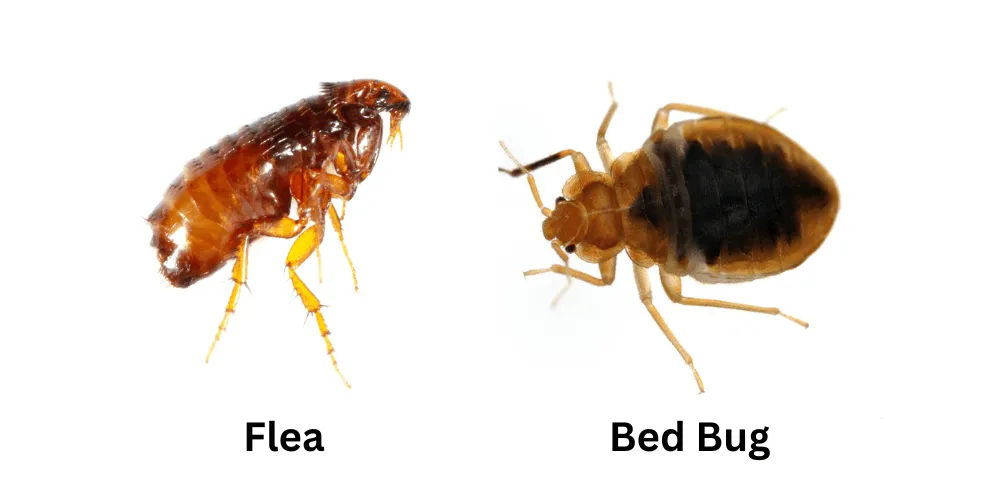Discovering bites on your skin without knowing their cause can quickly become a source of anxiety. When red marks show up overnight, many people immediately wonder whether they are dealing with fleas or bed bugs. Both pests are small, elusive, and feed on blood, yet their behaviors, habitats, and how they interact with your environment differ in important ways. Understanding these differences is not just about identification. It helps determine the right treatment and prevents wasting time and resources on the wrong solution. This guide provides a complete, experience-focused breakdown of what sets these pests apart and how to respond effectively.
Why Fleas and Bed Bugs Are Often Confused

People confuse fleas and bed bugs because their presence often goes unnoticed until bites appear. Both insects are active at night, leave behind itchy red marks, and are difficult to spot. These shared characteristics can make early detection frustratingly vague.
What complicates the issue further is how their signs overlap. Fleas typically enter homes through pets, but not everyone has pets, and bed bugs can appear even in spotless spaces. When the only clue is a skin reaction, misjudging the source is easy. For example, someone might treat their pets for fleas when the real issue lies in the mattress.
This confusion delays effective treatment. Flea and bed bug infestations grow rapidly, so identifying the source accurately saves time, reduces discomfort, and prevents escalation.
Similar Bite Reactions
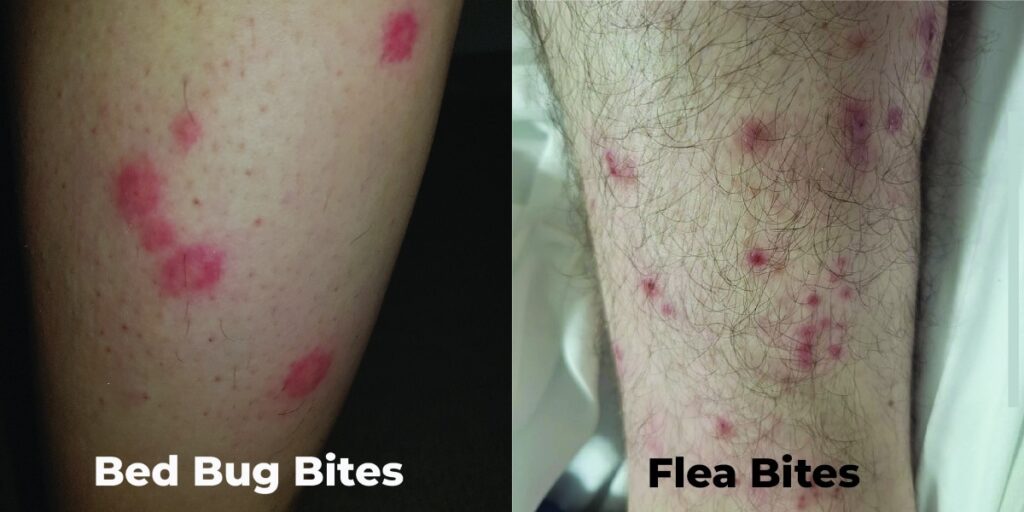
The most common sign of both pests is the appearance of small, red, itchy bumps. Flea bites tend to be concentrated around the ankles and lower legs, especially in homes with cats or dogs. Bed bug bites usually show up on the upper body: arms, neck, and back.
A key difference lies in the arrangement. Bed bug bites often form in straight lines or tight clusters due to their feeding pattern. Flea bites are more scattered. While both can cause itching, flea bites often itch immediately, whereas bed bug bites may take several hours to become noticeable.
Some individuals react more strongly to one than the other, leading to swelling or rash. However, bites alone do not provide definitive answers. Observing patterns can help, but full identification requires looking beyond symptoms.
Both Thrive in Warm Indoor Environments
Both fleas and bed bugs prefer warm conditions, which is why infestations often increase during summer or in heated indoor environments. Bedrooms, living rooms, and pet areas provide the perfect habitat for both insects to feed and reproduce.
Fleas depend on animals. If pets sleep indoors, fleas will settle in carpets, bedding, and floor cracks. Bed bugs, on the other hand, are drawn to body heat and carbon dioxide. They nest close to where humans sleep, often in the seams of mattresses or nearby furniture.
These insects also share a survival strategy: hiding. Both pests avoid open areas and light, choosing to remain hidden until feeding time. Their discreet habits make infestations grow silently, often for weeks before detection.
Overview: Fleas vs. Bed Bugs
Quick Comparison Table (Size, Color, Movement, Habitat)
| Feature | Fleas | Bed Bugs |
|---|---|---|
| Size | 1.5 to 3.3 mm | 4 to 7 mm |
| Color | Dark brown | Reddish-brown |
| Movement | Jump | Crawl |
| Habitat | Pets, carpets, floors | Mattresses, cracks, furniture seams |
What Fleas Look Like
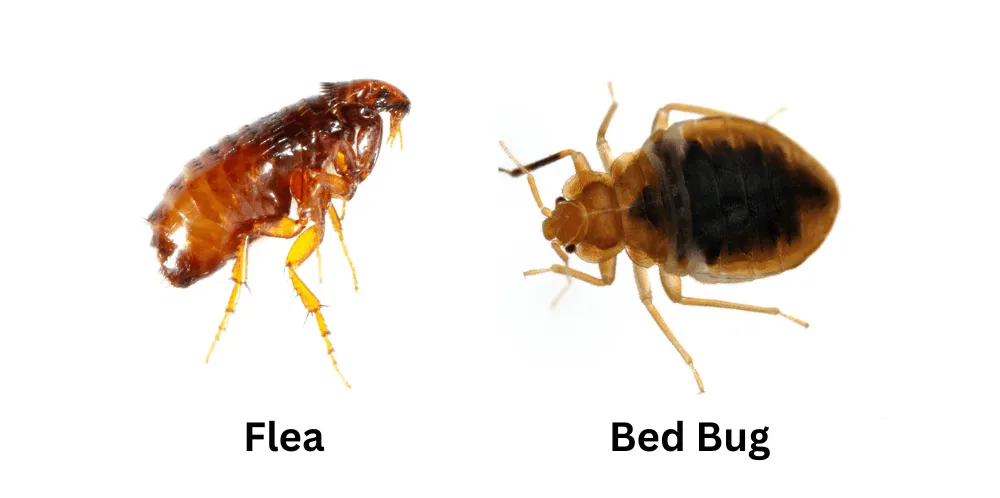
Size, Color, and Body Shape
Adult fleas are small and hard to spot. Their bodies measure around 1.5 to 3.3 millimeters and are dark brown with a narrow shape. The body is laterally compressed, allowing them to move easily through fur.
Their tough exoskeletons are difficult to crush, which helps them survive in active pet environments. Fleas also have bristles and legs adapted to gripping hair and fur, giving them both mobility and camouflage.
How Fleas Move and Jump
Fleas are known for their jumping ability. A single flea can leap over 30 centimeters horizontally and 18 centimeters vertically. This makes them capable of moving quickly between host and environment.
They rely on this movement to find food, escape threats, and relocate when disturbed. Their jumping makes infestations harder to contain, especially in carpeted rooms or pet bedding.
Common Places Fleas Hide
- Pet bedding and resting areas
- Deep carpets and rugs
- Floorboard cracks or under baseboards
Because fleas lay eggs in the environment, infestations are often rooted in areas the pet frequents. Eggs fall off the animal and hatch in quiet, hidden areas of the home.
What Bed Bugs Look Like
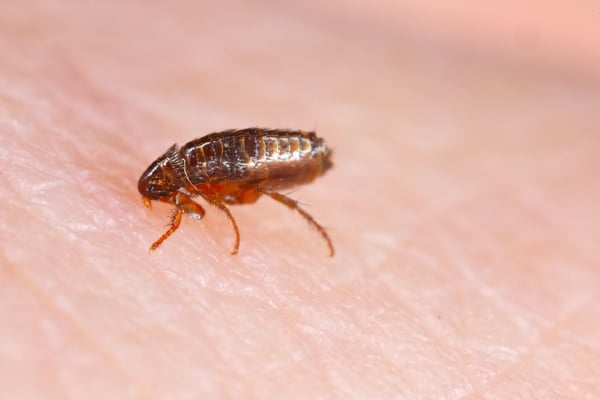
Size, Color, and Flattened Body
Bed bugs are slightly larger than fleas, measuring between 4 to 7 millimeters. Their bodies are flat and oval before feeding, becoming rounder and darker after feeding on blood.
The reddish-brown color helps them blend with wooden bed frames and upholstery. Their size allows them to hide in incredibly tight spaces, including the stitching of mattresses and behind wall hangings.
How Bed Bugs Move (Crawl, Don’t Jump)
Unlike fleas, bed bugs cannot jump. They crawl slowly and directly, often traveling only short distances to reach their host. This movement makes them easier to trap but harder to notice unless you’re actively looking.
Their crawling is silent and typically occurs at night. They follow warmth and carbon dioxide to locate people and feed, usually without waking the host.
Common Places Bed Bugs Hide
- Mattress seams and box springs
- Furniture joints and upholstery
- Wall cracks, behind pictures, and under peeling wallpaper
These locations are chosen for being undisturbed and close to the sleeping person. Bed bugs can go unnoticed for long periods if inspections are not thorough.
Flea Bites vs. Bed Bug Bites
Bite Pattern and Location
Flea bites often appear around the ankles, behind the knees, or in folds of skin. The placement reflects where fleas can easily access the body while the host is moving or stationary.
Bed bug bites usually appear on the upper body. Their bites are more linear because of how they move while feeding. You may see three or more bites in a row, sometimes called “breakfast, lunch, and dinner.”
Itching, Swelling, and Redness Differences
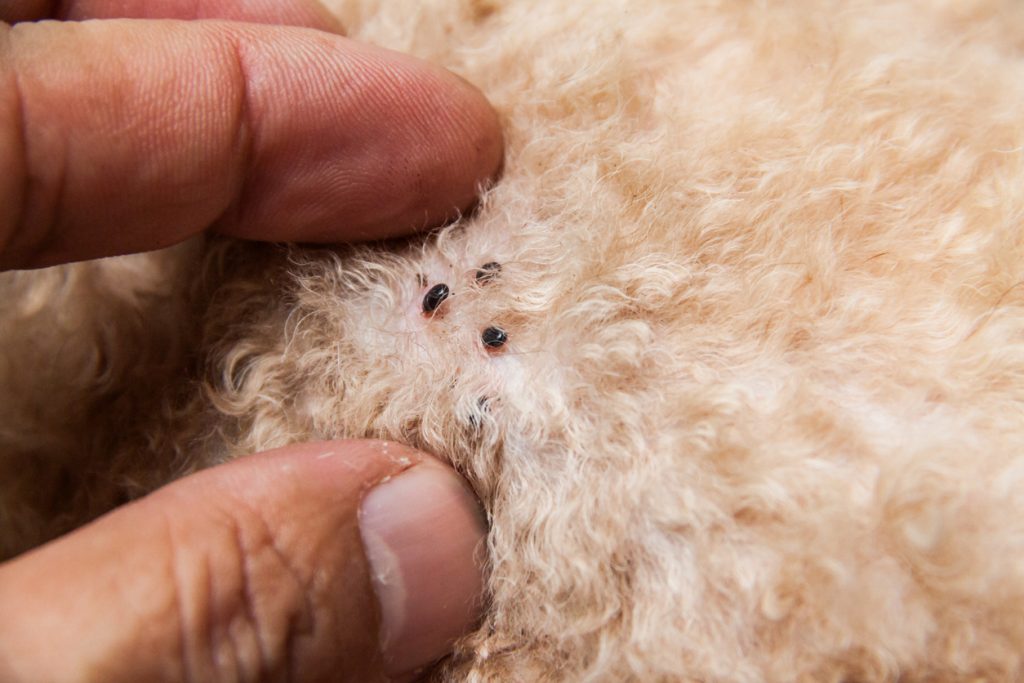
Flea bites often cause immediate, intense itching with a red center. Bed bug bites can take hours to become visible, and the itching is usually milder but longer lasting.
Scratching flea bites may cause small wounds or scabs. Bed bug bites may swell more and occasionally form blisters in sensitive individuals. The reaction depends on the person’s immune response and previous exposure.
How Long Bite Marks Last
Flea bite marks typically fade in two to three days if left alone. Repeated scratching, however, can lead to secondary infections or scarring.
Bed bug bites often persist for up to a week. In some cases, they can leave behind hyperpigmentation, especially on fair or sensitive skin.
Where You’ll Find Each Pest
Fleas – Pets, Carpets, and Floors
Fleas live primarily on pets, but their eggs and larvae exist in the environment. Homes with cats or dogs are especially vulnerable to flea infestations.
Flea activity is concentrated in soft materials like carpets, rugs, and pet beds. Vacuuming alone may not be enough to remove them, especially in heavily used pet zones.
Bed Bugs – Mattresses, Cracks, and Furniture Seams
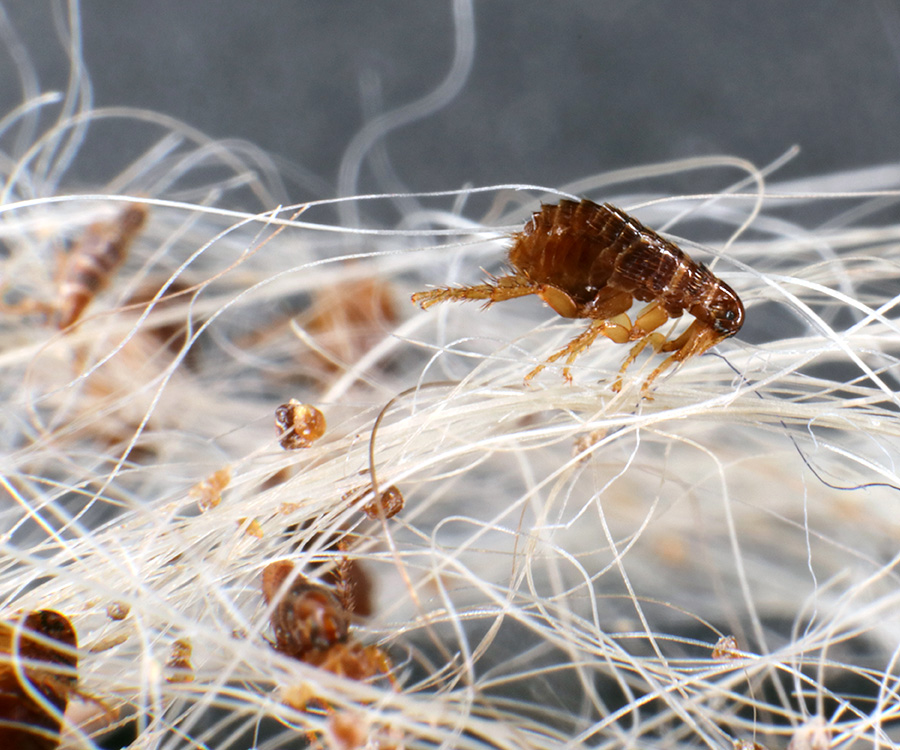
Bed bugs stay close to human sleeping areas. They hide during the day and emerge at night to feed, usually within two meters of the bed.
Infestations often begin in one room and spread slowly. Moving furniture or luggage between rooms can accelerate this process.
How to Tell If You Have Fleas or Bed Bugs

Behavior and Movement Cues
Fleas jump when disturbed and are more likely to be seen moving quickly across light surfaces. Bed bugs move slowly and are more likely to stay hidden unless the infestation is large.
If you see something jump when vacuuming or walking in socks across a carpet, you’re likely dealing with fleas. Crawling insects near your mattress usually point to bed bugs.
Signs on Bedding and Furniture
- Flea infestations often leave black specks (flea dirt) on pet bedding
- Bed bug infestations leave dark rust-like stains on sheets, often from crushed bugs or fecal droppings
Bed bugs also shed exoskeletons as they grow, which can accumulate in hiding spots. Flea signs are often limited to where pets rest.
Using Traps or Visual Inspections
Place light-based flea traps near pet areas to monitor activity. Inspect bedding and furniture seams with a flashlight to check for bed bugs.
If the pests are not easily visible, using sticky traps near bed posts or under furniture legs can help identify which insect is present.
How to Get Rid of Fleas vs. Bed Bugs
Flea Treatment Methods (Pets + Home)
Fleas require treatment on both the pet and in the environment. Use vet-approved oral or topical medications consistently, even after visible fleas are gone.
Wash all pet bedding in hot water and vacuum every corner of the home. Apply insect growth regulators to carpets and floors to disrupt the flea life cycle.
Bed Bug Treatment Methods (Heat, Steam, Chemicals)
Bed bugs need targeted, high-temperature treatment. Use a steamer on mattresses and furniture. Professional exterminators may use dry heat methods that raise the entire room temperature.
Chemical treatments can include residual sprays and desiccant dusts applied in cracks and crevices. Multiple rounds are often necessary for complete elimination.
Why Each Requires a Different Approach
Fleas live on animals and reproduce in the environment. You cannot eliminate them without treating both sources at the same time.
Bed bugs are environment-bound. They do not live on hosts, but near them. This means the focus must be on furniture, wall voids, and sleeping areas. Using pet treatments on bed bugs is ineffective, and vice versa.
Prevention Tips for Both Fleas and Bed Bugs
Regular Cleaning and Inspection
Vacuum carpets, mattresses, and furniture weekly. Pay attention to seams, cracks, and pet zones. Use mattress encasements to reduce hiding places for bed bugs.
Inspect luggage, clothing, and secondhand items before bringing them indoors. Travel is a common way to introduce bed bugs into a home.
Pet Treatment and Home Hygiene
Use monthly flea preventatives on pets. Keep your pet’s living area clean and their bedding laundered regularly.
For bed bugs, minimize clutter near beds and avoid placing bags or clothing on hotel furniture. Prevention is about reducing access and monitoring early signs.
When to Call a Pest Control Professional
Call a licensed exterminator if you see multiple bites without identifying the source, or if treatments have not worked after a week. Professionals use heat, residual insecticides, and follow-up inspections to ensure complete elimination.
Fleas and bed bugs both require precise treatment strategies. If you’re unsure which pest you’re dealing with, a professional can help confirm the source and create a targeted plan.
Conclusion: Fleas Jump, Bed Bugs Crawl, and Their Differences Affect Everything
The core difference is simple: fleas jump, bed bugs crawl. But that movement reflects deeper contrasts in behavior, habitat, and how they impact your living space. Fleas are tied to pets and live both on and off them. Bed bugs target humans and nest near sleeping zones. Correct identification is the key to solving the problem.
If you’re noticing unexplained bites, start by understanding what each pest looks like, where they hide, and how they behave. With the right knowledge, you can take faster, more effective steps to reclaim your space from unwanted intruders.
